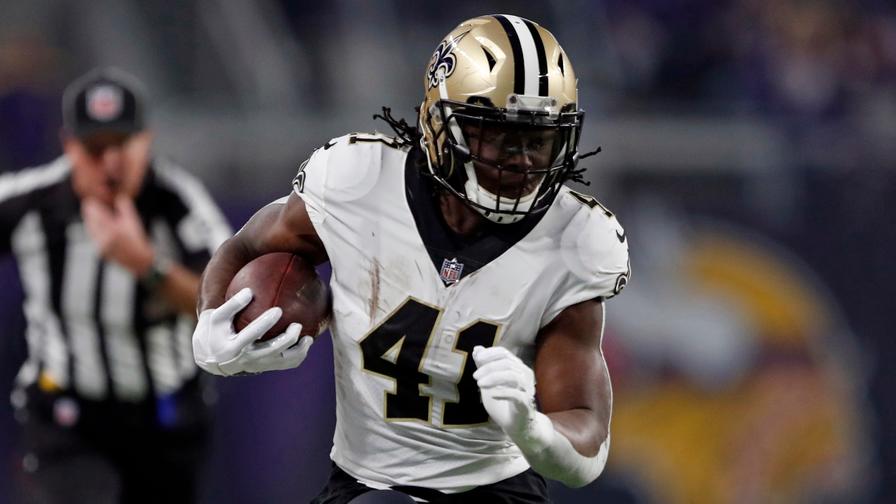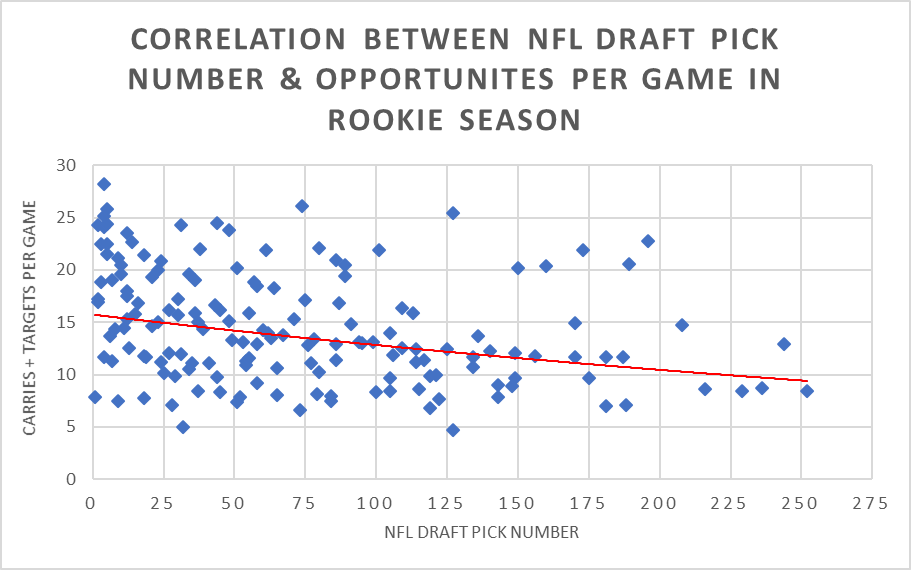Fantasy Football: Identifying Trends Behind Successful Rookie Running Back Performances

The running back position in the NFL is a very polarizing one. It is one of the most devalued positions in terms of salary allocation compared to all other offensive skill positions. We are consistently seeing injuries and high roster turnover at running back, and because of this many fantasy owners are utilizing the Zero RB Strategy due to the position's unpredictability.
That unpredictability has seemingly increased in recent years. The NFL has seen an explosion of rookie running backs being successful over the past decade, and with eight backs being drafted within the first three rounds of the 2018 NFL draft that trend could and should continue. The common thought process here is that most of these rookies (depending on the draft capital of the pick) come at a cheap cost compared to spending big money on a veteran in free agency.
We have seen successful rookie running back campaigns come from various draft positions.
In 2017, we got third-rounders Alvin Kamara and Kareem Hunt, and first-rounders Leonard Fournette and Christian McCaffrey. The year before Ezekiel Elliott was selected in the first round with Jordan Howard going off the board in the fifth. And in years prior, there was David Johnson (3rd Round, 2015), Todd Gurley (1st Round, 2015), Jeremy Hill (2nd Round, 2014), Eddie Lacy (2nd Round 2013), and so on and so on.
As fantasy owners, it is paramount to assess rookie running backs correctly these days. Currently, heading into the 2018 season, there are eight rookie running backs being drafted within the first eight rounds of 12-team PPR drafts, per Fantasy Football Calculator.
It makes sense. Fantasy GMs are looking to peg down the right guy. After all, over the last 10 seasons, an average of 2.3 rookie running backs have placed among the top 20 backs in PPR leagues. So let's try to help everyone out to see if we can find some trends to put us in the right direction in 2018.
The Higher the Pick the Bigger the Workload?
For a position that is highly devalued and seen as interchangeable for many NFL teams, using a high draft pick on a back like Fournette, Elliott and, this year, Saquon Barkley is often criticized and laughed at. Most owners and analysts believe there are many more important positional needs than to waste an early first round pick on a running back, which you can get later in the draft or cheap in free agency.
It would seem that common sense would tell us that the higher the draft pick a team uses on a running back the more heavily involved that player will be. While those picks mentioned above were mocked, the drafting teams got their fair share of mileage from Zeke and Fournette, who carried elite workloads. And Barkley should follow suit this season.
While it makes sense that the first round running backs get thrust into immediate volume, how does it look for other early round backs?
Below is a chart of all rookie running back seasons over the last 25 years, breaking down opportunities (carries and targets) per game (on the y-axis) and the overall selection they were drafted with (on the x-axis). The minimum requirements for this chart were 12 games played and 100 total touches (numbers via Pro Football Reference).
We see what we naturally expect to happen: the running backs picked early in the draft consistently see the most opportunities in their first seasons, and while there are some outliers past the third round, these guys typically find it hard to receive enough chances to produce similarly successful seasons.
Let's break it down a little further using the same data in the scatter chart above to look at opportunities per game by round (using a sample of 159 players).
| Draft Round | Opportunities Per Game |
|---|---|
| 1 | 16.8 |
| 2 | 14.5 |
| 3 | 14.2 |
| 4 | 11.7 |
| 5+ | 12.7 |
From this data, we can conclude that our best bet for finding a rookie running back to receive opportunities will more than often have been drafted from rounds one through three in the NFL Draft. As stated earlier in the piece, there were eight total running backs taken in the first three rounds of the NFL draft, so let's see if we can keep finding more trends to further narrow it down.
Team Qualities
A player's drafting team is vital to a player's success. Teams that are bad and forced to play from behind a majority of the season will put a damper on a rookie rusher's outlook. Teams that have poor offensive lines and a generally poor offense will be detrimental to their level of play as well.
The chart below lists the last 5 years' rookie running back seasons in which the back ended up ranking in the top 20 at the position and includes a few measures of team success, including Adjusted Net Expected Points per Play (Adj NEP/P), our in-house measure of a team's overall offensive efficiency on a per-play basis (for more on NEP, check out our glossary).
| Player | Year | Team | Record | Playoffs | Adj NEP/P (Rank) | OL Run Block Rank |
|---|---|---|---|---|---|---|
| Alvin Kamara | 2017 | NO | 11-5 | Yes | 0.15 (2nd) | 2 |
| Kareem Hunt | 2017 | KC | 10-6 | Yes | 0.12 (4th) | 12 |
| Leonard Fournette | 2017 | JAC | 10-6 | Yes | 0.06 (11th) | 13 |
| Christian McCaffrey | 2017 | CAR | 11-5 | Yes | 0.04 (15th) | 25 |
| Ezekiel Elliot | 2016 | DAL | 13-3 | Yes | 0.19 (3rd) | 4 |
| Jordan Howard | 2016 | CHI | 3-13 | No | 0.01 (23rd) | 8 |
| David Johnson | 2015 | ARI | 13-3 | Yes | 0.19 (1st) | 3 |
| Todd Gurley | 2015 | LAR | 7-9 | No | -0.04 (32nd) | 24 |
| Jeremy Hill | 2014 | CIN | 10-5-1 | Yes | 0.03 (17th) | 11 |
| Eddie Lacy | 2013 | GB | 8-7-1 | Yes | 0.06 (11th) | 5 |
| Giovani Bernard | 2013 | CIN | 11-5 | Yes | 0.04 (15th) | 11 |
| Le'Veon Bell | 2013 | PIT | 8-8 | No | 0.04 (16th) | 22 |
| Zac Stacy | 2013 | LAR | 7-9 | No | 0.04 (17th) | 12 |
There are a few common factors that stand out among these running backs. 10 of the 13 seasons (76.9%) saw the running back play for a team that finished the season with a .500 record or better, and nine of those made the playoffs (the only exception being the 2013 Pittsburgh Steelers).
In terms of team offense, 9 of the 13 rookie running backs' (69.2%) teams ranked in the top half of the league in Adjusted Net Expected Points per Play. And lastly, 10 of these backs (76.9%) were on teams with offensive lines that ranked 13th or better in run blocking, according to Football Outsiders.
Basically, this is telling us we want to target rookie running backs who project to be part of a good overall team, specifically a strong offense, and one with an above-average run blocking line.
Easy Path to Opportunities
Not only is the team a rookie is drafted to important for the above reasons, but also to determine if that running back falls behind on the depth chart, is a part of a training camp battle for the lead job or will be a part of a full-on committee.
In 2017, we saw Kareem Hunt average 20.9 opportunities per game while facing no competition in Kansas City, after Spencer Ware suffered a season-ending injury in the offseason. We also saw Kamara put up an absolutely insane fantasy season, but he was barely drafted in fantasy leagues because he found himself behind Mark Ingram, and while Kamara was an absolute stud, he did his work on only 13.75 opportunities per game.
For the most part, those 13 rookie running backs we touched on in the previous section had clear paths to volume based on weak competition in the backfield or injuries (outside of pass-catching backs in McCaffrey, Giovani Bernard and Kamara).
Conclusion
The path for a successful rookie season depends on a lot of things going the right way. The player needs to stay healthy and make the most of his opportunities. We saw talent come into play last season with Kamara on limited touches, and that was hard to predict as he's basically an exception all his own.
As fantasy owners, we tend to think in terms of opportunities and not necessarily talent. A player needs to play first and foremost, after all.
So we found some common trends and similarities between these successful rookie running back seasons that can be put to good use when assessing this year's rookie running back class. Look at guys picked in the first three rounds, target those with clear paths to volume and bet on them taking advantage of being on a good team with an established offensive line.

















